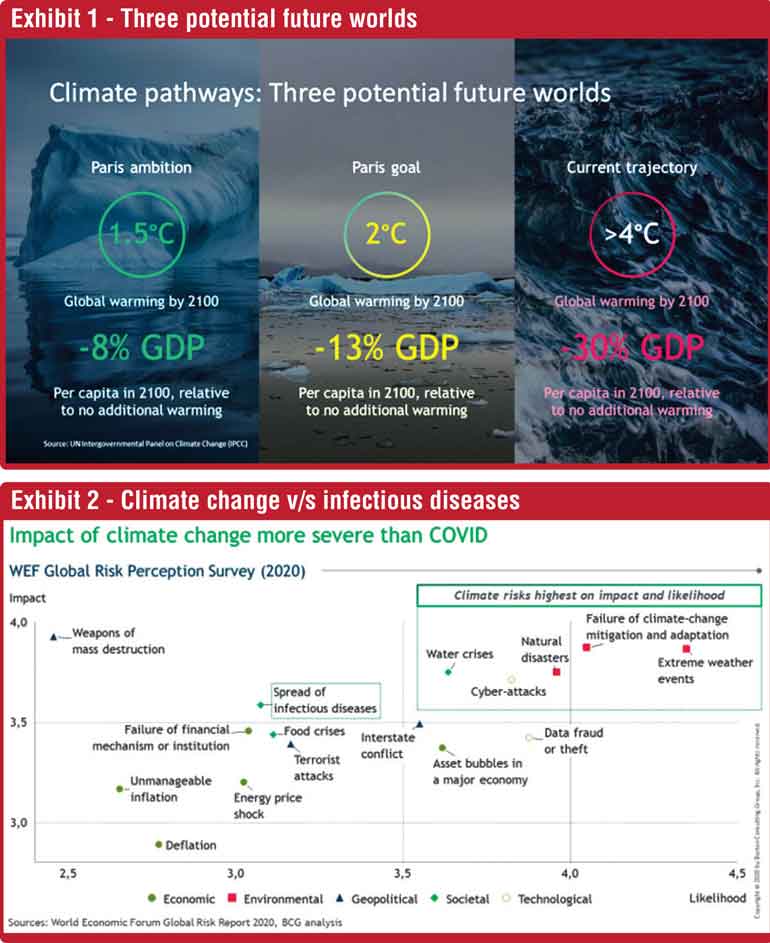Sunday Dec 07, 2025
Sunday Dec 07, 2025
Thursday, 14 October 2021 00:00 - - {{hitsCtrl.values.hits}}


Climate change is expected to have a graver impact than the COVID-19 pandemic. The consequences of climate action failure are more severe than disease as they are irreversible and gradual. The pandemic has led to some four million human deaths worldwide as of May 2021 and caused unprecedented damage to global economies. However, this impact is temporary and as per experts will last three to four years, depending on global vaccine rollouts.
action failure are more severe than disease as they are irreversible and gradual. The pandemic has led to some four million human deaths worldwide as of May 2021 and caused unprecedented damage to global economies. However, this impact is temporary and as per experts will last three to four years, depending on global vaccine rollouts.
Climate change, on the other hand, puts all life forms at risk and can cause a permanent drop of 30% in global GDP per capita by 2100. Our cities are at a risk of getting submerged, many countries will run out of water by 2030 and climate migration will become a reality we will be forced to live with. The current trajectory of climate change will lead us to >4 degree Celsius of global warming by the year 2100. In addition, it increases the risk of future pandemics, according to the World Economic Forum’s Global Risks Perception Survey.
Hence, climate change is a matter of great concern for the world, and Sri Lanka is no exception. It ranks 23 (out of 180) in countries at most risk from climate change. In terms of climate change readiness, it ranks 101 (out of 190 countries) as per University of Notre Dame’s ND-GAIN index. The fact that it is an island country makes it more susceptible to the impact of rising sea levels. Nearly 25% of its population lives in coastal areas and is vulnerable to floods, displacement, and reduced water availability.
Secondly, extreme heat and drought are a threat to human life, as well as the economy as it impacts key industries such as agriculture and tourism. Sri Lanka’s annual emissions have grown at a CAGR of 4% from 2010 vs 3% from 2000, indicating an urgency to act in response to the situation. Currently, non-renewables such as coal and oil form 55% of the country’s energy mix and sectors with the largest share of emissions are transportation (28%), electricity (23%) and agriculture (17%).
The world is following two approaches for combatting climate change – Mitigation and Adaptation. Mitigation refers to reducing emissions of greenhouse gases and enhancing activities that reduce these gases from the atmosphere (e.g., worldwide push on renewables, electrification, energy efficiency etc.), whereas Adaptation refers to creating resilience by adjustment of natural and socio-economic ecosystems to a changing climate and related hazards (e.g., building flood defences, drought resistant crops etc.). Each country is following a different approach.
Historically, the focus of global climate action has been centred around mitigation. For example, Malaysia’s ambition is to be carbon neutral by 2050, Germany has built a decarbonisation roadmap until 2050, and Denmark plans to deliver on 70% emission reduction by 2030 for four key sectors (energy-intensive industries, manufacturing, aviation and waste and water). However, it is getting increasingly clear that focus on mitigation alone will not be enough. Given Sri Lanka’s high vulnerability to climate change, it must focus on both mitigation of emissions and driving adaptation at scale across critical systems like agriculture, water and coastal infrastructure.
China, India, Indonesia and Brazil are among the developing countries that are also allocating funds towards adaptation strategies. For instance, China is building sponge cities that absorb water by constructing wetlands for rainwater storage, construction of permeable roads and pavements to protect against floods. Philippines is building homes with disaster resilient material and elevated water tanks to protect from typhoons in coastal areas.
Spend on agriculture adaptation is high in countries where it is a key sector like India and Brazil. For example, India is driving adoption of resilient agriculture, and creating resilient water supply network to combat the problems of drought. Zimbabwe is using a drought resistant variety of maize which significantly boosts yield by 600kg/hectare compared to conventional maize.
In conclusion, there are five pressing questions for Sri Lanka as it thinks about curbing climate change:
How should Sri Lanka set climate ambition balancing focus on both mitigation and adaptation priorities?
What pathways will Sri Lanka choose to meet its ambition across policies, regulations, incentives and investments?
How can Sri Lanka access international financing pools for climate action?
How will the newly formed Task-force interface with stakeholders i.e., ministries, businesses, and industry bodies as it thinks about transitioning to a green economy?
How should Sri Lanka develop a delivery engine for effective execution of various initiatives?
[Boston Consulting Group is a premier global management consulting firm founded in 1963. BCG partners with leaders in business and society to tackle their most important challenges and capture their greatest opportunities. BCG’s Center for Climate Insights has supported over 120 projects on climate strategy for governments and businesses across the globe. We also have partnerships with leading global climate conferences such as COP26 (UN), WEF, OGCI, BDI, etc. BCG is committed to helping the world fight the war against climate change and has pledged to reaching net-zero climate impact as a firm by 2030.]
(This article was authored by Chilman Jain, Principal, Rajarshi Bhattacharya, Principal, and Natarajan Sankar, Managing Director & Partner from Boston Consulting Group.)